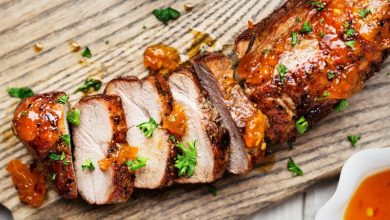🍽️ Asian Lemongrass Pork: A Flavorful Delight 🍋🐖
Asian Lemongrass Pork, also known as “Thit Heo Nuong Xa” in Vietnamese cuisine, is a delightful dish known for its aromatic and zesty flavor. Let’s dive into its history, components, preparation steps, and the time it takes to create this mouthwatering dish!
📜 History:
This dish is a popular Vietnamese creation that showcases the influence of French and Southeast Asian cuisine. During the French colonial period, Vietnam embraced ingredients like lemongrass and herbs, blending them with their culinary traditions. Lemongrass pork became a staple in Vietnamese cuisine, and it has since spread worldwide due to its incredible taste.
🥘 Components:
To make this dish, you’ll need the following key components:
- Pork: Typically, you’ll use thinly sliced pork loin or pork shoulder.
- Lemongrass: Fresh lemongrass stalks are the star of the show. They’re known for their citrusy aroma and flavor.
- Garlic: Fresh garlic cloves or garlic paste for an extra punch of flavor.
- Fish Sauce: A fundamental ingredient in Southeast Asian cuisine, it provides saltiness and depth of flavor.
- Soy Sauce: Adds richness and color to the dish.
- Sugar: Often palm sugar or brown sugar for a subtle sweetness.
- Chili Peppers: For a kick of heat (adjust to your spice preference).
- Oil: To marinate the pork and for grilling or pan-frying.
👩🍳 Preparation Steps:
-
Marinate the Pork:
- Slice the pork thinly.
- In a bowl, combine minced lemongrass, garlic, fish sauce, soy sauce, sugar, and chopped chili peppers.
- Marinate the pork in this mixture for at least 30 minutes, but longer for more flavor is better.
-
Grilling or Pan-Frying:
- If grilling, skewer the marinated pork or use a grill pan.
- If pan-frying, heat some oil in a pan.
- Cook the pork until it’s caramelized and cooked through.
-
Serving:
- Serve your lemongrass pork over a bed of rice or with rice noodles.
- Garnish with fresh herbs like cilantro, mint, and basil.
- Don’t forget a side of nuoc cham dipping sauce, a classic Vietnamese condiment made from fish sauce, lime juice, sugar, water, and chili.
⏲️ Time Needed:
The time required to prepare Asian Lemongrass Pork depends on the marinating time and the cooking method:
- Marinating: At least 30 minutes (longer for better flavor, up to 24 hours).
- Grilling or Pan-Frying: Around 15-20 minutes.
Overall, you can have this flavorful dish ready in around 45 minutes to 1 hour, including preparation and marinating time.
Enjoy your Asian Lemongrass Pork adventure – it’s a true culinary delight that balances tangy lemongrass, savory pork, and a touch of heat in every bite! 🍋🐖🍽️😋
🍽️ Nutrition Facts and Health Information for Asian Lemongrass Pork 📊🍋🐖
Here’s an overview of the nutrition and health aspects of this delicious Asian Lemongrass Pork dish:
🔹 Nutrition Facts (per serving, approximate):
- Calories: 250-350 calories (varies with portion size and cooking method).
- Protein: 25-30 grams.
- Fat: 10-15 grams.
- Carbohydrates: 10-15 grams.
- Fiber: 1-2 grams.
- Sugar: 5-8 grams.
🔹 Health Information:
-
Protein-Rich: Asian Lemongrass Pork is a good source of protein, making it a satisfying meal that can help with muscle maintenance and growth.
-
Healthy Fats: While it contains some fat, it’s often lean pork, and the fat content can be controlled during cooking. Use lean cuts and minimal oil for a healthier option.
-
Low in Carbs: This dish is relatively low in carbohydrates, which can be beneficial for those looking to manage their carb intake.
-
Lemongrass Benefits: Lemongrass, the star ingredient, is known for its potential health benefits, including anti-inflammatory and antioxidant properties. It can also aid digestion.
-
Fish Sauce: While fish sauce is a significant component, it’s high in salt, so it’s advisable to use it in moderation, especially if you have high blood pressure. There are low-sodium alternatives available.
-
Fresh Herbs: The garnish of fresh herbs adds a nutritious element to the dish, providing vitamins and antioxidants.
-
Chili Peppers: If you like it spicy, the chili peppers can add a dash of capsaicin, which may boost metabolism and offer some pain relief.
-
Balanced Meal: When served with a side of vegetables or in a rice or noodle bowl, this dish can be part of a well-rounded and satisfying meal.
Remember, the nutritional content can vary based on the specific ingredients and preparation methods you use. If you’re looking for a healthier version, consider using leaner cuts of pork, less sugar, and moderate oil in the preparation.
As with any dish, moderation and balance are key to enjoying it as part of a healthy diet. 🥗🍽️😊




